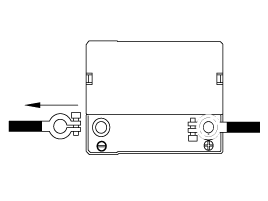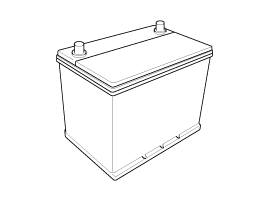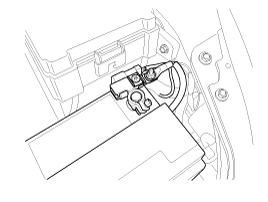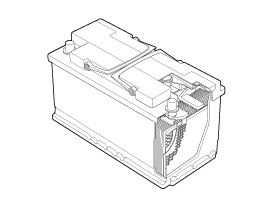Remove the battery from the vehicle.
Care should be taken in the event the battery case is cracked or leaking, to protect your skin from the electrolyte.
Heavy rubber gloves (not the household type) should be wore when removing the battery.


Perform the following steps to complete the load test procedure for maintenance free batteries.
Connect the load tester clamps to the terminals and proceed with the test as follow:
If the battery has been on charge, remove the surface charge by connect a 300ampere load for 15 seconds.
Connect the voltmeter and apply the specified load.
Read the voltage after the load has been applied for 15 seconds.
Disconnect the load.
Compare the voltage reading with the minimum and replace the battery if battery test voltage is below that shown in the voltage table.
Voltage | Temperature |
9.6V | 20°C (68.0°F) and above |
9.5V | 16°C (60.8°F) |
9.4V | 10°C (50.0°F) |
9.3V | 4°C (39.2°F) |
9.1V | -1°C (30.2°F) |
8.9V | -7°C (19.4°F) |
8.7V | -12°C (10.4°F) |
8.5V | -18°C (-0.4°F) |
If the voltage is greater shown in the table, the battery is good.
If the voltage is less than shown in the table, replace the battery.
Make sure the ignition switch and all accessories are in the OFF position.
Disconnect the battery cables (negative first).
Remove the battery from the vehicle.
Care should be taken in the event the battery case is cracked or leaking, to protect your skin from the electrolyte.
Heavy rubber gloves (not the household type) should be wore when removing the battery.

Inspect the battery tray for damage caused by the loss of electrolyte. If acid damage is present, it will be necessary to clean the area with a solution of clean warm water and baking soda. Scrub the area with a stiff brush and wipe off with a cloth moistened with baking soda and water.
Clean the top of the battery with the same solution as described above.
Inspect the battery case and cover for cracks. If cracks are present, the battery must be replaced.
Clean the battery posts with a suitable battery post tool.
Clean the inside surface of the terminal clamps with a suitable battery cleaning tool. Replace damaged or frayed cables and broken terminal clamps.
Install the battery in the vehicle.
Connect the cable terminals to the battery post, making sure tops of the terminals are flush with the tops of the posts.
Tighten the terminal nuts securely.
Coat all connections with light mineral grease after tightening.
When batteries are being charged, an explosive gas forms beneath the cover of each cell. Do not smoke near batteries being charged or which have recently been charged. Do not break live circuit at the terminals of batteries being charged.
A spark will occur when the circuit is broken. Keep open flames away form battery.

ISG (Idle stop & go) system equipped vehicle always use the AGM battery only. If flooded battery has installed, this can potentially lead to engine electrical trouble or ISG system error.
Disconnect the battery terminals, negative first.

Remove the battery bracket.
Replace same capacity of the AGM battery.
AGM battery-60Ah

Install the battery bracket and connect the terminals.
Ensure the AGM battery is placed correctly on the battery tray.
In all cases, an AGM battery must be installed and the battery sensor calibrated for the ISG system to function.
After the battery has been changed or disconnected, the battery sensor must be recalibrated.
After connecting the battery, start the engine at least once.
Then park the car for at least 4 hours with the ignition off in the ignition switch OFF door closed, hood switch off state.
After the 4 hours, the engine should be started two times. At this time the battery sensor will be recalibrated. (Refer to "Battery sensor recalibration procedure" in FL group)
But first 25 times, the ISG function can operates regardless of ISG system stability for ISG function operating check.
Do not open the AGM battery.
The AGM battery must not be opened under any circumstances as the introduction of oxygen from the air will cause the battery to lose its chemical equilibrium and rendered non-operational.